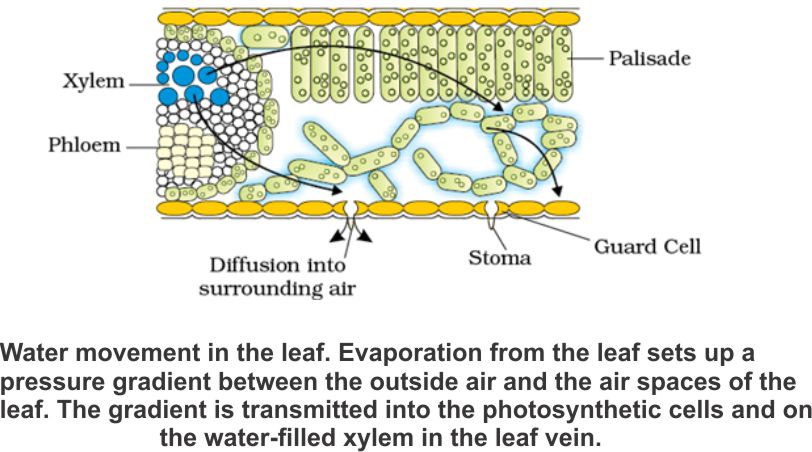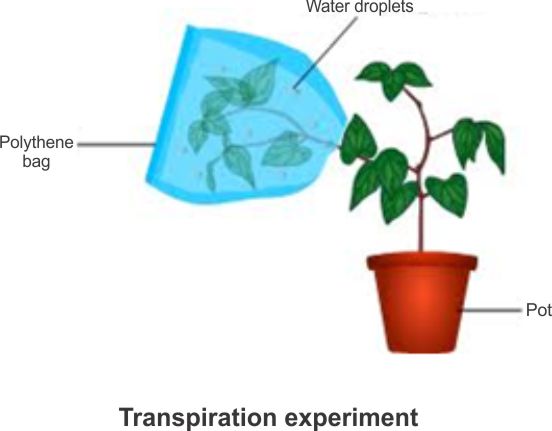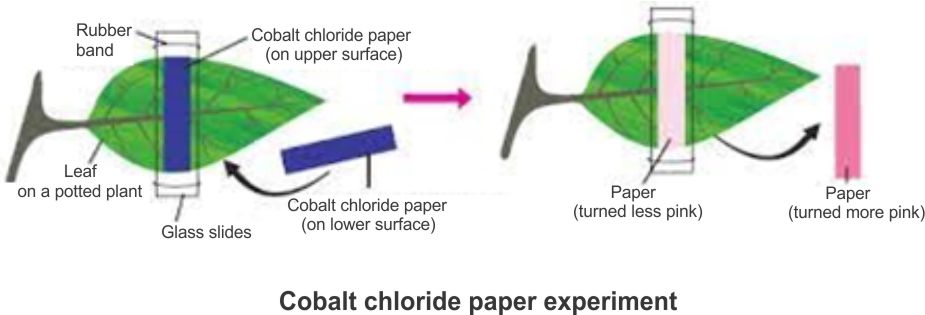ABSORPTION OF WATER AND ASCENT OF SAP
- Absorption of water refers to the process by which plant roots take in water from the soil.
- Roots, particularly the root hairs, are crucial for water absorption.
- Absorption occurs through diffusion, where water moves from regions of higher concentration in the soil to lower concentration in the root cells.
- Thin-walled extensions of root epidermal cells that significantly increase the surface area for absorption.
- Root hairs absorb water along with mineral solutes purely through diffusion.
- The experiment with a twig in coloured water highlights the movement of water through vascular bundles, specifically the xylem.
- Understanding the mechanism of long-distance transport in plants is crucial for comprehending nutrient and water distribution.
- Diffusion is insufficient for long-distance transport due to its slow pace.
- Over short distances, diffusion is effective, but for extensive movements, additional mechanisms are required.
- The movement of a molecule across a typical plant cell takes about 2.5 seconds for a distance of 50 µm. Calculate the time required for a 1 m distance by diffusion alone.
- Water, minerals, and food are transported by mass or bulk flow systems.
- Mass flow involves substances moving en masse due to pressure differences, unlike diffusion where substances move independently.
- Bulk movement of substances through plant vascular tissues is termed translocation.
- Xylem and phloem are highly specialized vascular tissues associated with translocation.
- Xylem primarily translocates water, mineral salts, some organic nitrogen, and hormones from roots to aerial plant parts.
- Xylem ensures efficient upward movement of substances against gravity.
- Ascent of sap refers to the upward movement of water through the plant, particularly from the roots to the aerial parts.
- Phloem translocates a variety of organic and inorganic solutes, predominantly from leaves to other plant parts.
- Two-Way Transport: Phloem facilitates bidirectional movement, supporting the overall nutrient distribution.
- Vascular Tissue Specialization:
- Roots, Stems, and Leaves: Cross-sections reveal the specialized vascular system in higher plants.
- Xylem and Phloem: These tissues play distinct roles in nutrient and water transport.
Ascent of sap
- Ascent of sap refers to the upward movement of water through the plant, particularly from the roots to the aerial parts.
- Xylem, the specialized vascular tissue, is responsible for the upward transport of water, minerals, and some organic nitrogen and hormones.
- Vessels and tracheids within the xylem facilitate the bulk flow of water.
- Roots are the primary sites for water absorption in plants.
- Root hairs, present at the tips of roots, play a crucial role in water and mineral absorption.
- Root hairs, extensions of root epidermal cells, significantly increase the surface area for absorption.
- Water and minerals are absorbed by root hairs through diffusion.
- Water Movement in Roots:
- Apoplast Pathway: Water moves through the system of adjacent cell walls (apoplast), excluding the casparian strips of the endodermis. This pathway involves mass flow and relies on water's adhesive and cohesive properties.
- Symplast Pathway: Water travels through interconnected protoplasts via plasmodesmata, involving cytoplasmic strands. Movement is relatively slower, occurring down a potential gradient.

- Apoplastic movement is dominant due to loosely packed cortical cells.
- Casparian strip in the endodermis prevents water movement through the apoplast, directing it through the symplast.
- Water enters xylem vessels and tracheids, which are non-living conduits and part of the apoplast.

- Symbiotic association of fungus with the root system, enhancing water and mineral absorption through a vast fungal surface area. Mutualistic exchange involves minerals and water provided by the fungus and sugars by the plant roots.
- Some plants, like Pinus, depend on mycorrhizae for germination and establishment.
- Driving Forces for Ascent of Sap:
- Root Pressure: Pressure exerted by water entering the roots creates a force propelling water upwards.
- Capillarity: Adhesive and cohesive properties of water enable capillary action, aiding the rise of water through narrow tubes like xylem vessels.
- Transpiration Pull: Water loss through transpiration creates tension, resulting in a negative pressure that pulls water upwards.
Transpiration pull
- Water ascends through the xylem at impressive rates, reaching up to 15 meters per hour.
- Unlike animals with a circulatory system, plants lack a heart, yet they efficiently transport water.
- The mechanism behind water movement—whether it is 'pushed' or 'pulled'—has long intrigued researchers.
- Transpiration from leaves is identified as the primary force propelling water upwards.
- Cohesion-Tension-Transpiration Pull Model:
- The prevailing model for water transport, emphasizing the cohesive and tensional properties of water coupled with transpiration.
- The cohesion between water molecules and tension generated by transpiration collaboratively contribute to the pull.

- Despite its transient nature, less than 1% of water reaching leaves is utilized for photosynthesis and plant growth.
- Most water is lost through stomata in leaves, a phenomenon recognized as transpiration.

- Transpiration experiment: Enclosing a healthy plant in a polythene bag to observe water droplets formed inside.

- Cobalt chloride paper, turning color upon absorbing water, serves as a tool to study water loss from leaves.
